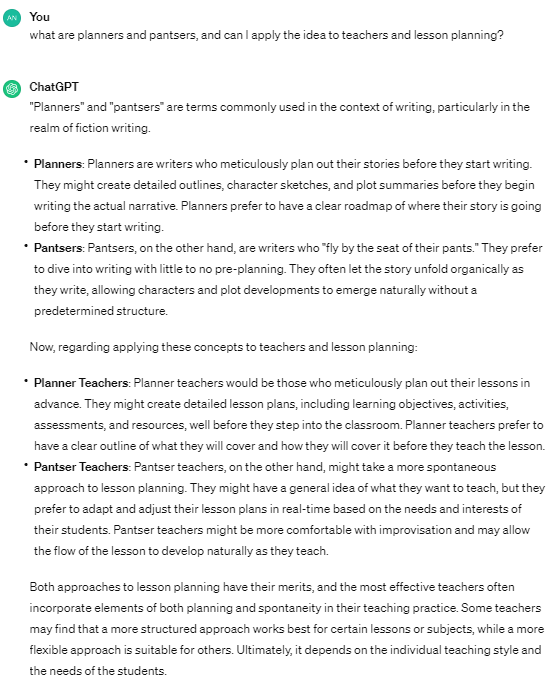The original version of this post was partially behind the paywall. I am now making it available to everyone.
I don’t know when it started, but in the last few years I’ve read references to writers being either “Planners” or “Pantsers”. One of the earliest references to this idea that I could find is in a 2010 post on the National Novel Writing Month (NaNoWriMo)1 blog.
There are two types of writers in the NaNoWriMo universe. There are pantsers, and there are planners. Pantsers fly by the seat of their pants. (Hence the name.) They have some vague idea or a main character or even just an opening line, and when November 1 rolls around, they jump on board the story train and see where it takes them.
Planners know what their novel is going to be about before November 1 [the start of National Novel Writing Month] rolls around. They know their characters, their setting, their story. There are different degrees of planners, mind you. Some people write more in their outline than they do in the novel itself, with pages and pages of character sketches and world building and elaborate plot spiderwebs. Others will just do a quick overview and have a general idea of where the story goes. But when you get right down to it, you’re either a planner or a pantser.
This has been discussed to death all over the internet, and once you know about it, it’s hard not to notice it in different types of fiction writing. It is easy to spot whether television dramas are well-planned, or the writers are improvising from week to week.
Of course, I’m going to apply this idea to teaching. I suspect that how I will apply it must be immediately obvious to anyone who has ever taught. It’s obvious to the point that even a machine could figure out what I’m going to say next, so I asked a machine to say it for me. Here’s what the Cyberdyne Systems Model 101 (otherwise known as ChatGTP) said:2
Planner Teachers: Planner teachers would be those who meticulously plan out their lessons in advance. They might create detailed lesson plans, including learning objectives, activities, assessments, and resources, well before they step into the classroom. Planner teachers prefer to have a clear outline of what they will cover and how they will cover it before they teach the lesson.
Pantser Teachers: Pantser teachers, on the other hand, might take a more spontaneous approach to lesson planning. They might have a general idea of what they want to teach, but they prefer to adapt and adjust their lesson plans in real-time based on the needs and interests of their students. Pantser teachers might be more comfortable with improvisation and may allow the flow of the lesson to develop naturally as they teach.
Both approaches to lesson planning have their merits, and the most effective teachers often incorporate elements of both planning and spontaneity in their teaching practice. Some teachers may find that a more structured approach works best for certain lessons or subjects, while a more flexible approach is suitable for others. Ultimately, it depends on the individual teaching style and the needs of the students.
That’s so scarily close to what I would have said that it has probably ruined blogging for me forever. However, before I am permanently replaced by automata, I will discuss the idea and my own experiences. I will explain why I think leaders need to know which of their colleagues are Planners and which are Pantsers.
Now available to everyone: a real person writes a blog post
Perhaps the perspective of an actual human being is needed to point out that the level of flexibility teachers have available to them when teaching is at least partly dictated by the curriculum and the resources available. I’m a maths teacher (which I believe is still technically a type of human being) in a department where most of the teaching takes place from workbooks. I’ve tended to notice that in my department the biggest difference between the Planners and the Pantsers is probably that the Planners want all the answers to the exercises in the workbook available to them before the lesson, and the Pantsers are happy to answer the questions for the first time in front of the class, or crowdsource answers from the pupils. An extreme Pantser may even wait until ten minutes into the lesson before popping off to the store cupboard to find the workbooks that they’ve had all term to collect, but I digress.
I am Andrew and I am a Planaholic
I am a Planner. I work part-time, at least partly, so that I rarely have to worry about having too little time to plan. I prefer to write resources from scratch rather than work around a suboptimal resource during a lesson. I rarely even improvise examples these days, even though as a full-time teacher I would do that almost every lesson. I hoard resources, both physical and digital, and will remember a textbook page from ten years ago if it has precisely the right task at exactly the correct level of difficulty. I fear facing a class without a register, a seating plan to tell me who I’m speaking to, and resources with a complete set of answers. And when I say I fear this, I mean I genuinely have nightmares about turning up to a lesson unprepared. It’s not that I was never spontaneous, it’s just that over twenty-two years of teaching, I have learnt not to improvise if I can avoid it.
Having declared my commitment to #TeamPlanner, I can still point out the negatives of the Planner mindset. Sometimes I waste precious time preparing for contingencies that never arise. I tend to do more than my fair share of photocopying. I am bad at teaching cover lessons, particularly ones that I don’t know about long in advance. If I can, I prepare seating plans and spare resources even for a cover lesson in a subject I am unfamiliar with. Even in my subject, I confess I will tend to slow down a lesson unnecessarily if I fear that I will have to cover more than the material I’ve prepared. I seem to grow more uncomfortable improvising each year, and while I’m writing this blog post I am recalling spontaneous teaching practices that used to work well, which I have let fall by the wayside. I used to be very good at improvising extension questions that would keep the most able pupils busy, and yet now I cannot remember the last time I did that. Similarly, surprise mental tests and spontaneous verbal questions seem to have vanished from my teaching repertoire.
On the other hand, Pantsers suck
However, I am fully aware of the disadvantages of being on #TeamPantser. I have observed lessons where the teacher improvised a set of simultaneous equations to solve that had no real answers. I have seen pupils who expect to spend the first five to ten minutes of a lesson as an extension of break time as the teacher searches for the class’s exercise books and the resources or equipment for the lesson. I have had pupils knock on my classroom door and ask for teaching supplies that their teacher somehow doesn’t have to hand. I have heard tales of lessons that failed because the teacher did not realise beforehand that they weren’t as familiar with the content of the lesson as they thought. Too much planning wastes time, but too little planning can lead to disaster.
Working with Planners and Pantsers
Both planning and improvisation are important skills for every teacher to have. Making a case for some degree of balance seems easy, and I am not trying to be conciliatory when I say the teaching profession needs a mix of Planners and Pantsers. However, when the difference between Planners and Pantsers affects how people work together, it can also be the difference between success and failure. If a class is shared between a Planner and a Pantser, it can be highly stressful. Expectations will differ drastically about what needs to be communicated between those teachers between lessons. The Pantser will not be able to give the Planner sufficient information to prepare their lessons. The Planner will waste time giving the Pantser information that they don’t want. Differing expectations may even mean some material isn’t covered or some is covered twice. Similar issues will affect curriculum planning and setting cover lessons. When Planners have to teach from resources prepared by Pantsers or vice versa, then both parties will be unhappy with the outcome. It is very difficult for a committed Planner to prepare a lesson for a committed Pantser, or the other way around. If a happy medium is not quickly established, nobody will be happy.
These considerations are particularly important for leadership. Work that involves systems, schedules, rotas, routines, consistency or logistics should always be given to Planners. Work that involves spontaneously reacting to situations, or navigating the unknown, should be given to Pantsers. Leaders should want Planners to make sure that crises hardly ever occur, and Pantsers to come up with immediate solutions the moment they do. Planners are usually pessimists, anticipating problems and outlining a response to them. Pantsers are usually optimists, confident that if a problem does occur, then everyone will be able to muddle through. If your school trip, sports day, new discipline system or new curriculum is planned by Pantsers and relies on your Planners to respond effectively to the unexpected, it will probably be a disaster. If an initiative or event is planned by Planners, but gives the Pantsers the responsibility for responding to emergencies, it will go well. This is a pattern I have seen time and time again.
Leaders should also be aware that identical policies might have massively different workload implications for Planners and Pantsers. Telling a Planner that “you don’t have to do this any more” is pointless if what you are telling them to do is an indispensable part of their lesson preparation that they will not want to do without. Equally, asking a Pantser to produce a detailed plan covering details they would normally sort out on the fly might involve many unnecessary trips back to the drawing board. There may be teachers who are too extreme in their planning or pantsing, who require some form of intervention to change their ways. However, for people who are already effective teachers, telling Planners to improvise more or Pantsers to plan more is likely to be counterproductive and reduce their enthusiasm and effectiveness.
If you want to steal this money-making idea, at least pay for a year’s subscription first
If I were interested in making a fortune, I would now be inventing and patenting the Andrew Old Planning/Pantsing Inventory with its accompanying 150-page questionnaire. Or perhaps I would be setting up a consultancy that offers CPD sessions for school leaders with titles like “Getting the most from your Pantsers” and “Managing your Planners effectively”. I do think school leaders should record which of their employees are Planners and which are Pantsers. I recommend that they take this into account before distributing responsibilities or delegating any important duties. They should probably do this by keeping all this information on an enormous spreadsheet that codes everything in twenty-seven different colours. But, of course, I would think that; I’m a Planner. Somebody with a different temperament might suggest school leaders should be vaguely aware of these differences, while making it up as you go along.
I first became aware of NaNoWriMo when I listened to this podcast about a bizarre scandal on the NaNoWriMo forums. The story starts at 21:45, but be warned, I am not claiming that my life was enriched by knowing about any of this.






